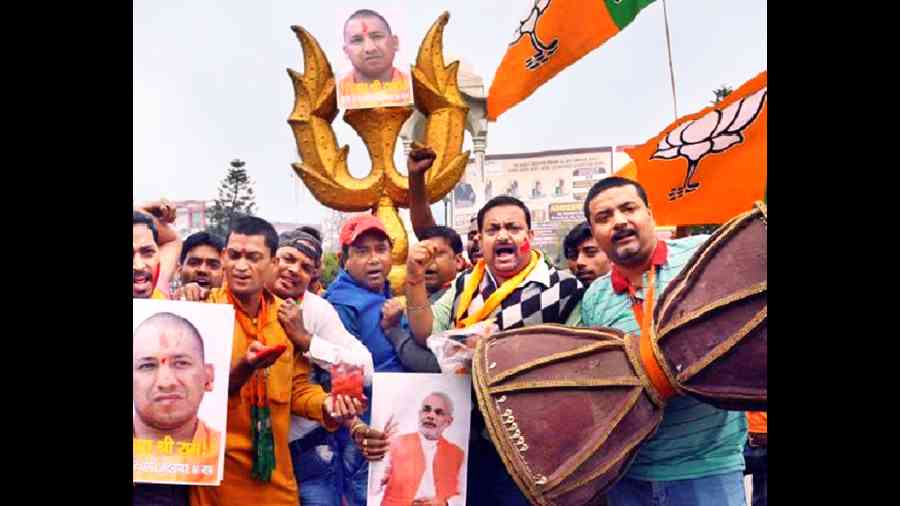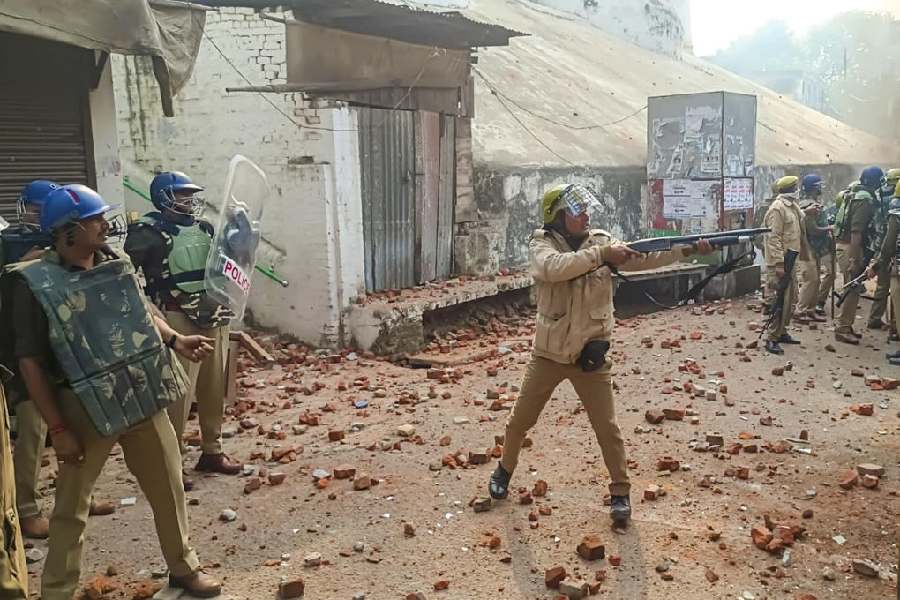The historian, Ian Copland, once contrasted the polar conceptions of Hindutva leadership held by the two competing Hindu political organisations of the mid-20th century: the Hindu Mahasabha and the Rashtriya Swayamsevak Sangh. V.D. Savarkar of the Mahasabha preferred a near-dictatorial model, extolling the Hindu rulers of princely states as the “bedrocks of Hindu power” and idolising the “only Hindu kingdom” of Nepal. The sangh parivar, meanwhile, committed itself to a long-term project of remaking the nation through the gradual entrenchment of ideology and organisation, both of which demanded a system of collegial political leadership.
Not surprisingly, the RSS model proved to be more sustainable. As the Mahasabha crashed and burnt through splits and defections, the RSS adapted itself by promoting a bevy of leaders acceptable to the political mainstream. It has taken more than seven decades for the sangh parivar to feel secure enough in the infrastructure of Hindu rashtra to tolerate something akin to an ersatz Hindu royalty, as reflected in the surreal pageantry on display recently at the Narendra Modi stadium in Ahmedabad.
Yet, Modi is today not the only claimant for the title of the ‘Hindu Hriday Samrat’. Yogi Adityanath has now ascended to the level of charismatic Hindutva leadership only achieved by Modi before. We can furnish three pieces of evidence from the last few months.
One, the Mood of the Nation poll of January this year that showed that 39% of the people considered Adityanath to be the best chief minister of the country. This is similar to the extent of popular approval enjoyed by Modi a decade back: in the same poll of January 2013, 36% had wanted Modi to be prime minister.
Two, the Uttar Pradesh Global Investors Summit in February where Adityanath received the resounding stamp of the Indian Establishment. As the mainstream media went to town highlighting the ‘34 lakh crore investment’ figure, the industrialist, Mukesh Ambani, heralded the “golden age of Uttar Pradesh” under Adityanath. While Ambani termed the state the “centre of hope for all of India”, President Droupadi Murmu christened Uttar Pradesh as the “growth engine of New India.”
Third, Nitin Gadkari, a senior minister, last week compared Adityanath to “Lord Krishna” and saw in his transformative actions (such as using the bulldozer for protecting ‘good citizens’ and destroying ‘wicked ones’) the potential of ram rajya. Given that the political base of Gadkari is considered to lie in the RSS headquarters of Nagpur, one might assume that he was also channelling the sentiments of his patrons. To sum up, three months into the year, Adityanath has checked off the troika of prime ministerial qualifications in New India — support of the Hindutva base, the business establishment, and the RSS leadership.
This is not to say that Adityanath is now in a position to challenge Modi for the top leadership; just that he has leapfrogged other contenders.
A decade back, when the Hindutva-media-business ecosystem was building up the leadership cult of Modi for an impending national role, Adityanath was merely what the English media routinely describes as a ‘fringe bigot’, commanding the goonish Hindu Yuva Vahini in Gorakhpur. Adityanath thus provides a fascinating case study to understand the construction of a charismatic Hindutva leadership. It is important to recognise that the source of this charisma is not merely to be found in the personal attributes of the leader, although the theme of renunciation of worldly ties and a sense of the interlocking of personal and social missions derived from a ‘Hindu worldview’ do play a significant part. Yet, of even more importance is the political context and the political subjectivities of the electorate that play a critical part in constituting this charismatic leadership. Let’s turn to three key aspects of this political context.
First, the democratic ‘crisis of accountability’ that the political scientists, R. Jenkins and A.M. Goetz, identified in Uttar Pradesh in their book, Reinventing Accountability. In brief, three fundamental changes in the political economy that accelerated roughly after liberalisation meant that the patronage networks commanded by the Samajwadi Party and the Bahujan Samaj Party no longer satisfied the evolving electorate. One, faster rate of rural economic growth (especially in the 2000s) meant that fewer people depended directly on the agricultural economy. Two, political de-centralisation in conjunction with the rising economic aspirations empowered non-dominant backward caste groups that were only marginally covered by the patronage networks of parties such as the SP. This transformation of the political economy of caste structures through the process of deepening democratisation has been captured by Gilles Verniers in his study, “The localization of caste politics in Uttar Pradesh after Mandal and Mandir”. Three, the fragmentation of the State and the capture of the economic-bureaucratic networks by local elites (empowered in part by decentralised party electoral machines) fed into a sense of popular disillusionment with the prospect of holding the State to democratic accountability.
This kind of democratic crisis was vividly captured by the French political philosopher, Claude Lefort, in The Political Forms of Modern Society: Bureaucracy, Democracy, Totalitarianism. Lefort’s contribution to democratic theory lay in the idea of ‘radical indeterminacy’ being an inescapable characteristic of a functioning democracy. In other words, modern democracy was hobbled by a latent uncertainty about its own foundations and legitimacy unlike the clear lines of authority embedded in traditional structures. The fragmentation of the authority of the State caused by never-ending contestations and negotiations between competing groups can sometimes lead to a crisis of democratic legitimacy. The consequent pining for popular sovereignty (an overarching sense of shared purpose or mission) is then leveraged by totalitarian groups, which, according to Lefort, explained the success of the radical fascist and communist political formations in the first half of the 20th century.
The anthropologist, Lucia Michelutti, has characterised the Adityanath government as a centralised, authoritarian regime modelled on the ‘monopolistic mafia raj’ that he had instituted in Gorakhpur as the head monk of the Goraknath temple. In her words, “the charismatic Kshatriya Yogi fuses in his persona divine kingship and democratic popular sovereignty.” The reference to Lord Krishna by Gadkari was not incidental. Rabindranath Tagore had called Krishna the “Kshatriya Prophet”, a practitioner of the ‘doctrine of yoga’ who channelled the ‘tradition’ of the ‘kingly prophets’. The invocation also reflects the political appeal of Adityanath among the middle-caste peasantry such as the Jats, Gujjars and, to some extent, the Yadavs, particularly in western Uttar Pradesh, that have undergone a prolonged social process of ‘kshatriyaisation’. However, this ‘kshatriyaisation’ has not always fed neatly into the Hindutva project. For instance, the SP and the Rashtriya Lok Dal have also utilised this process of identity formation into a muscular assertion of the political interests of Yadavs and Jats. Adityanath’s persona has been instrumental in the sangh parivar’s project of recalibrating this flow of societal upward mobility towards the purposes of Hindutva.
A recent paper on the Muzaffarnagar riots by the political scientists, Bulutgil H. Zeynep and Prasad Neeraj, juxtaposes the socio-economic data of the city with the incidence of violence and puts forth two key findings. First, the riots were “strategically selective,” meaning that the “BJP and their affiliates incited violence” by “specifically targeting communities with Hindu Jats and Muslims, where the pre-existing experience of intercommunal alliance constituted an electoral obstacle for the BJP.” Second, communal violence was neatly correlated with the intra-group inequality found in different villages: areas with high inequality between Jats and relatively poor, lower-caste Hindus witnessed the highest intensity of violence.
To borrow from the cartoon, The Powerpuff Girls, anti-Muslim mobilisation and everyday communal violence is the critical ‘Chemical X’, which upholds and lends vitality to the new Hindu socio-political structure in states like Uttar Pradesh. Bulldozers and encounters enable the “routinization of charisma” of Adityanath’s leadership (in the formulation of the sociologist, Max Weber) by embedding anti-Muslim mobilisation into routine State processes. The resultant Hindu political unity is then fed into grand missions (such as Adityanath’s project of a ‘one trillion dollar economy’), which might not result in much but satiate the hunger for, and celebrate the achievement of, a new ‘Hindu’ popular sovereignty. Adityanath has evolved into the foremost expositor of this ‘Hindu sovereign’ role, which has made him not only the most powerful chief minister of the country but also the leading contender for the prime minister of New India.
Asim Ali is a political researcher and columnist











